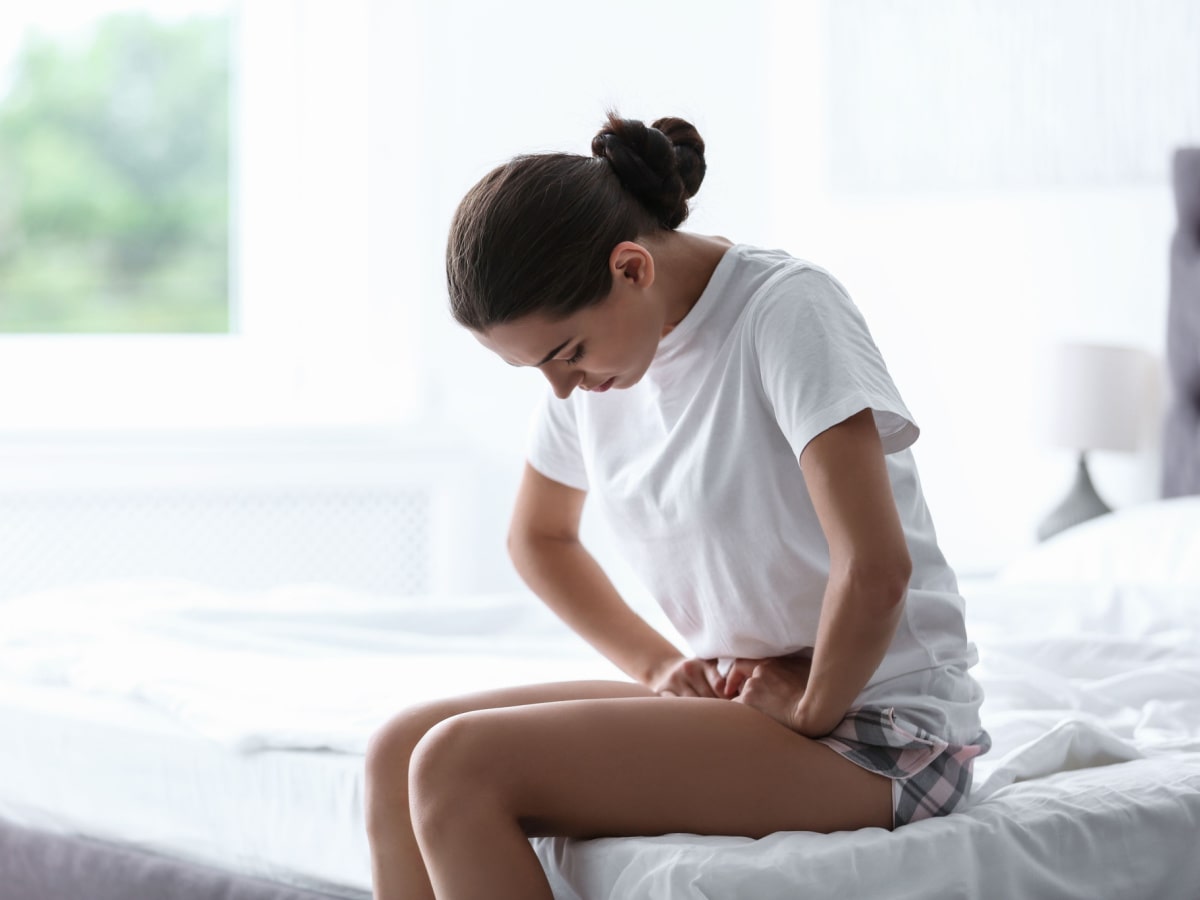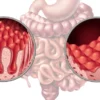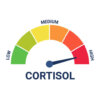
Endometriosis is a condition that can be present in women of reproductive age. It involves the abnormal presence of endometrial tissues outside of the uterus. This abnormal location of this tissue is commonly associated with symptoms such as pelvic pain and infertility.
Endometriosis affects 10-15% of all women of reproductive age. Endometriosis has also been indicated to affect 70% of women with chronic pelvic pain.
For most women with this condition, there is a significant delay in the diagnosis of this condition. In those aged 18-45 years, the average delay from the start of symptoms to the diagnosis is 6.7 years. [1, 2]
What is Endometriosis and what are the stages?
Endometriosis is a condition where the cells that are normally only found lining the uteruses are also found elsewhere. The most common site for these is the ovaries.
These cells behave in the same way as if they were in the uterus. This means that they respond to the cycle-related changes in hormones resulting in inflammation. This can then lead to many of the symptoms of endometriosis.
During the diagnosis of endometriosis, the severity of the condition is often graded on a scale of 1-4.
- Stage 1 involves minimal involvement of other tissues and only a few areas where uterine cells are found.
- Stage 2 involved more areas of affected tissue which also started to penetrate deeper into the tissue.
- Stage 3 is a moderate form of endometriosis with many more sites of implantation as well as scar tissue involvement.
- Stage 4 is the most severe form of endometriosis which involved not only scar tissue but also adhesions that can be thick as well as deeper implantation. [3]
What causes Endometriosis?
The exact cause of endometriosis is not known however there are several theories about the possible causes of endometriosis.
One theory involves retrograde menstruation which is where during a period there is the flow of the endometrial lining through the fallopian tubes into the pelvic space. This had the potential to lead to the ‘seeding’ of endometrial tissue outside of the uterus.
It has however been noted that retrograde menstruation is common among women while endometriosis is less so. This means that it happens in many women who do not go on to develop endometriosis.
This has led to the understanding that other factors are required for the onset of endometriosis.
Additional factors may be central to determining if the endometrial deposits develop. These include:
- Hormones (Endometriosis is an oestrogen-dependent disease and high levels of oestrogen have been linked to the pathogenesis of endometriosis)
- Inflammation
- The immune system
What are the symptoms of Endometriosis

The symptoms of endometriosis can vary from woman to woman. The most common symptoms include:
- Intermenstrual bleeding
- Painful periods (dysmenorrhea)
- Painful intercourse (dyspareunia)
- Chronic pelvic pain
- Painful defecation (dyschezia)
- Painful urination (dysuria)
It is also possible for someone to not have these symptoms but still have endometriosis. This can often be discovered when being evaluated for infertility. [4]
Also Read: Endometriosis and IBS – What’s The Connection?
Risk Factors of Endometriosis
While a single factor does not mean that endometriosis will develop, a range of factor appear to be involved with increasing the risk of the onset of this condition.
Many of these factors are related to hormones and the menstrual cycle and include:
- Periods that last more than 7 days
- At a young age when menstruation began
- Not having given birth
- Estrogen levels that can be considered elevated
- Having a menstrual cycle of less than 28 days
However, the use of oral contraceptives and pregnancies is associated with a decreased risk.
It has been observed that females with a higher BMI (body mass index) have an increased risk. This may relate to the potential hormonal differences in heavy vs lean females.
Diagnosis of Endometriosis
The first stage of diagnosis is made based on clinical history. While there are physical examinations that can indicate the possibility of endometriosis this can also be present in other conditions. For example, pelvic pain which is common in endometriosis is also present in other conditions such as pelvic adhesions, adenomyosis as well as gastrointestinal disorders.
When diagnosing endometriosis, other causes of pelvic pain are often ruled out through tests. The tests include urinalysis, pap smear, pregnancy test, and vaginal and endocervical swabs. Additionally, pelvic ultrasound scans are carried out to assist in the diagnosis of endometrioma, fibroids or ovarian cysts.
A type of ultrasound called a transvaginal ultrasound is a key investigation that helps to assess the endometrium and uterine cavity. While this can help to identify the presence of endometrial cysts, it does not rule out peritoneal endometriosis. Due to the location of peritoneal endometriosis, it does not show on ultrasound but via a laparoscopy.
While there are preliminary tests that can be carried out, a laparoscopy with histological confirmation is considered the gold standard for diagnosing endometriosis. [5, 6]
Endometriosis and Gut Health
Links have been found between gut health and hormonal conditions nsuch as endometriosis. This is not only due to the proximity of the digestive tract and the reproductive organs. It is also related to inflammation and the immune response within the gut as well as the balance of the gut bacteria.
IBS and endometriosis share common symptoms of a chronic state of inflammation and recurrent abdominal pain. Due to the close symptom presentation, it is possible for endometriosis and IBS to coexist and also for them to be misdiagnosed. It has also been indicated that women with endometriosis have a higher risk of also having IBS when compared to women without endometriosis.
Studies have reported that women with more severe IBS symptoms are more likely to have minimal to moderate endometriosis, compared with women with a more moderate or severe level of endometriosis. Also reported was the fact that the removal of endometrial lesions leads to a significant improvement in IBS symptoms.
However, while IBS and endometriosis can coexist in the same person that does not mean that one causes the other. [7]
Endometriosis and gut bacteria
Studies have identified key differences in the gut microbiome in those with endometriosis. A key factor is that the diversity of the gut microbes (seen as an indicator of the health and resilience of the gut microbiome) was significantly lower in those with endometriosis.
Animal studies have also indicated that the gut microbiome plays a role in disease progression. This was shown in a study in mice where when given antibiotics, there was a reduction in inflammation and endometriosis lesions. This is backed by other studies that indicate a higher presence of specific gut bacteria that promote inflammation in those with endometriosis.
These are organisms such as:
- Proteobacteria
- Enterobacteriaceae
- Streptococcus
- Escherichia coli
The gut microbiome influences the levels of oestrogen that circulate in the body. As already discussed, oestrogen is understood to play a central role in the development of endometriosis.
It has been reported that imbalances in gut bacteria (due to their impact on levels of circulating oestrogen) can indirectly influence disease state and progression in endometriosis. [8]
Treatment Options for Endometriosis
There are natural as well as medication approaches to the treatment of endometriosis.
The medical approaches include:
- Pain medications such as non-steroidal anti-inflammatories.
- Hormonal medications, such as the oral contraceptive pill.
- Surgery can vary between the removal of sections of affected tissue to a hysterectomy.
A range of natural approaches have also been found to address the underlying causes of endometriosis.
These include:
- Probiotics
- Boswellia
- Vitamin D
- Vitamins C and E
- Omega 3 fish oils
Diet patterns have also been found to play a role in both the prevention and treatment of endometriosis. They include:
To limit:
- Red meat
- Dairy
- High-fat meals
To include:
- Dietary fibre
- Seaweed
- Polyphenols
- Vitamins, C, D, E
What happens if endometriosis is left untreated?
If endometriosis is felt untreated, there is an increased risk of certain complications.
These include:
- Fertility issues
- Adhesions
- Bladder and bowel issues
Fertility Issues
- It’s understood that damage to parts of the reproductive such (ovaries and fallopian tubes) may continue to fertility issues.
Adhesions
- Adhesions develop and lead to certain organs adhering/sticking together in the pelvic region.
Bladder and bowel issues
- Endometriosis may impact the bowel or the bladder. These may be on the surface or penetrate deeper into the tissue. This may then contribute to painful bowel movements as well as painful intercourse.
Also, if endometriosis is left untreated for a long period of time and surgery is then required, this may make the surgery more complicated. This can be due to the level of tissue infiltration and the size of the areas impacted. [13]
Conclusion
While endometriosis and IBS are 2 separate conditions, endometriosis can contribute to digestive complaints. This means it can be important to work with a practitioner who understands both conditions, how the symptoms overlap and the approaches that can be taken.
These approaches include not only lifestyle adjustments but dietary approaches as well as evidence-based supplements.
Frequently Asked Questions about Endometriosis
Are alcohol and coffee bad for endometriosis?
The link between alcohol and coffee intake and endometriosis is unclear. This may be partly due to the stage of the female’s life and their fertility status.
For infertile women, a higher intake of coffee and alcohol may increase the risk of endometriosis development. This is understood to be due to the increased levels of circulating oestrogen which may then promote the growth of endometrial tissue outside of the uterus. [1]
Also Read: Can Coffee Cause Bloating?
Is smoking bad for endometriosis?
The link between smoking and endometriosis is unclear. While smoking has many negative health implications, in some it is associated with a reduced risk of endometriosis while in others it increases the risk of development.
Some studies have found that those exposed to smoke in the uterus have an 80% reduced risk of developing endometriosis. However, it has also been reported that exposure to passive smoke during childhood increases the risk.
While the exact mechanisms are unknown, smoking is understood to increase levels of oestrogens which may induce the growth of endometrial tissue.
References
- Parasar, Parveen et al. “Endometriosis: Epidemiology, Diagnosis and Clinical Management.” Current obstetrics and gynecology reports vol. 6,1 (2017): 34-41. doi:10.1007/s13669-017-0187-1
- Giudice LC, Kao LC. Endometriosis. Lancet. 2004 Nov 13-19;364(9447):1789-99. doi: 10.1016/S0140-6736(04)17403-5. PMID: 15541453.
- Pašalić E, Tambuwala MM, Hromić-Jahjefendić A. Endometriosis: Classification, pathophysiology, and treatment options. Pathol Res Pract. 2023 Nov;251:154847. doi: 10.1016/j.prp.2023.154847. Epub 2023 Oct 4. PMID: 37844487.
- Sinaii, Ninet et al. “Differences in characteristics among 1,000 women with endometriosis based on extent of disease.” Fertility and sterility vol. 89,3 (2008): 538-45. doi:10.1016/j.fertnstert.2007.03.069
- Bulun SE. Endometriosis. N Engl J Med. 2009 Jan 15;360(3):268-79. doi: 10.1056/NEJMra0804690. PMID: 19144942.
- Kennedy S, Bergqvist A, Chapron C, D’Hooghe T, Dunselman G, Greb R, Hummelshoj L, Prentice A, Saridogan E; ESHRE Special Interest Group for Endometriosis and Endometrium Guideline Development Group. ESHRE guideline for the diagnosis and treatment of endometriosis. Hum Reprod. 2005 Oct;20(10):2698-704. doi: 10.1093/humrep/dei135. Epub 2005 Jun 24. PMID: 15980014.
- Chiaffarino F, Cipriani S, Ricci E, Mauri PA, Esposito G, Barretta M, Vercellini P, Parazzini F. Endometriosis and irritable bowel syndrome: a systematic review and meta-analysis. Arch Gynecol Obstet. 2021 Jan;303(1):17-25. doi: 10.1007/s00404-020-05797-8. Epub 2020 Sep 19. PMID: 32949284.
- Leonardi M, Hicks C, El-Assaad F, El-Omar E, Condous G. Endometriosis and the microbiome: a systematic review. BJOG. 2020 Jan;127(2):239-249. doi: 10.1111/1471-0528.15916. Epub 2019 Sep 19. PMID: 31454452.
- Xholli A, Cremonini F, Perugi I, Londero AP, Cagnacci A. Gut Microbiota and Endometriosis: Exploring the Relationship and Therapeutic Implications. Pharmaceuticals (Basel). 2023 Dec 7;16(12):1696. doi: 10.3390/ph16121696. PMID: 38139822; PMCID: PMC10747908.
- D’Amico R, Impellizzeri D, Cordaro M, Siracusa R, Interdonato L, Crupi R, Gugliandolo E, Macrì F, Di Paola D, Peritore AF, Fusco R, Cuzzocrea S, Di Paola R. Regulation of Apoptosis and Oxidative Stress by Oral Boswellia Serrata Gum Resin Extract in a Rat Model of Endometriosis. Int J Mol Sci. 2022 Dec 5;23(23):15348. doi: 10.3390/ijms232315348. PMID: 36499679; PMCID: PMC9736785.
- Barnard, Neal D et al. “Nutrition in the prevention and treatment of endometriosis: A review.” Frontiers in nutrition vol. 10 1089891. 17 Feb. 2023, doi:10.3389/fnut.2023.1089891
- Nodler JL, DiVasta AD, Vitonis AF, Karevicius S, Malsch M, Sarda V, Fadayomi A, Harris HR, Missmer SA. Supplementation with vitamin D or ω-3 fatty acids in adolescent girls and young women with endometriosis (SAGE): a double-blind, randomized, placebo-controlled trial. Am J Clin Nutr. 2020 Jul 1;112(1):229-236. doi: 10.1093/ajcn/nqaa096. PMID: 32453393; PMCID: PMC7326593.
- Stochino Loi, Emanuela et al. “Effect of ultramicronized-palmitoylethanolamide and co-micronized palmitoylethanolamide/polydatin on chronic pelvic pain and quality of life in endometriosis patients: An open-label pilot study.” International journal of women’s health vol. 11 443-449. 12 Aug. 2019, doi:10.2147/IJWH.S204275
History
- Updated by Martin Cohen – 05/08/24






